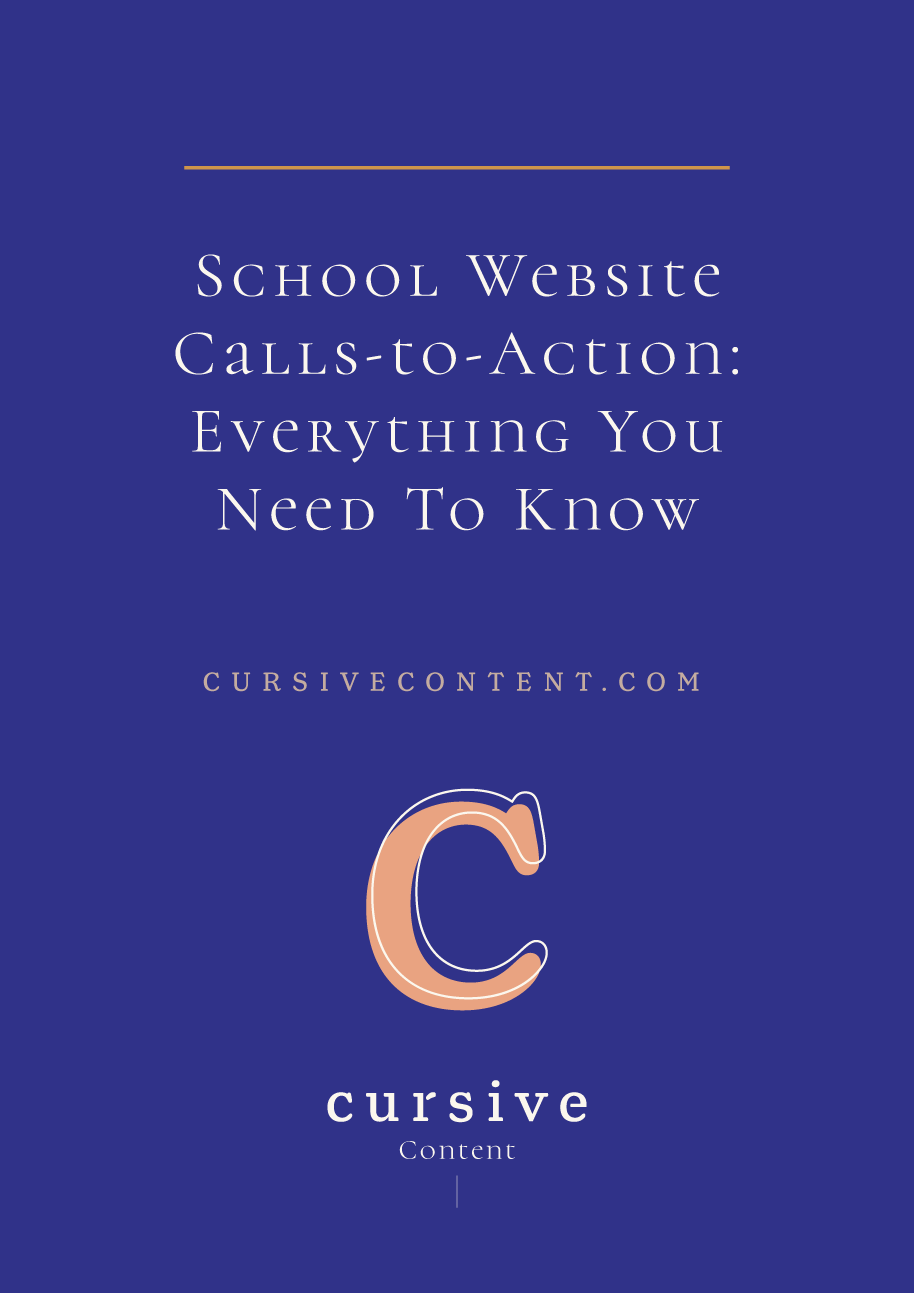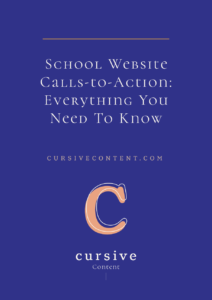School Website Calls-to-Action: Everything You Need To Know

Your school’s website needs big ideas, bold headlines, and eye-catching graphics.
It’s all about capturing your audience’s attention, right?
Right. Except…that’s not all.
Because what happens when you’ve done that really well? You have their attention. They’re reading/watching/listening. And now, you need a compelling call-to-action.
In case the phrase “call-to-action” has crossed over into meaningless marketing gibberish, let’s step back.
What is a call-to-action, and why does it matter?
New: Audience-First School Storytelling Kit
Want to learn exactly how to win over dream families with breakthrough school storytelling? This on-demand kit includes instant access to:
- In-depth video workshop
- Workshop workbook
- Family survey template
- Email template
- Voice of Customer research spreadsheet
- Audience persona template
- Sample dream family persona

A call-to-action is just what it sounds like: a request that your audience takes a specific action.
What that action is will vary, but it should connect with the topic your audience has just finished reading/watching/listening to, and it should connect to your overall marketing goals.
The goal of a call-to-action is to encourage further interaction with your school (whether online or in real life), to make readers aware of something you offer (for example, a program or event) and, in some cases, can prompt them to share their information with you.
It’s what takes readers from simply checking out your content and then leaving forever to keeping them connected to your school. A great call-to-action catches readers when they’re interested and engaged, and prompts them to stay that way.
To create a call-to-action that connects with your audience and converts them into loyal readers, prospects, students, donors and involved alumni, make it:
Relevant
Ensure the action you’re asking your audience to take directly relates to your school and the content they’ve just read.
Actionable
Use action words and give the audience something they can do right now. Make it as easy as possible for them to do what you’re asking.
Some power words to try: Join, Access, Discover, Download, Learn, Start
Direct
Craft your CTA so clearly that the reader will have no questions about what they need to do and what they’ll get from doing it. Less is more; try to keep it under 150 characters.
Audience-centric
Craft your call-to-action in a way that connects with your target audience. Make sure it takes into account what they care about and the programs/information you know they’re interested in. Ask yourself: Is it about them, or is it about you?
Since your school has multiple audiences (prospective students, students, alumni, donors and more) make sure the call-to-action is appropriate for the audience segment for whom the content is intended. Make it personal and give your audience ownership by using words like: I, My, You, Your
Aligned with your goals
The specific action you ask readers to take should support your marketing goals.
Exclusive & urgent
People love having insider’s information, and they’re also more compelled to act if they know there is a chance they’ll miss out. This one comes with a big caution though: Use exclusivity and urgency carefully. For example, your school’s catalog is available any time, for anyone, so implying it’s only available to some people or that it’s only available for a limited time would only come across as inauthentic– you can still build urgency by adding a word like “now”.
To encourage a feeling of exclusivity, use words and phrases like: Request an invitation, Subscribers only, Limited spots, Exclusive, Access, Pre-register
To amp up the urgency: Limited time, Last chance, Immediately, Before, Offer ends on [date], Limited spots, Members-only, Now
Your calls-to-action can be placed:
- At the end of a blog post
- After the last line of copy on a web page
- In your website’s sidebar
- At the end of a video or audio recording
- On printed materials, such as brochures and catalogs
- Within content when relevant, either in line with the copy or in a callout box
- In a clickable button
Now, let’s look at some CTA examples that utilize the principles outlined above.
Swipe these 35 call-to-action examples and make them your own:
- Download your college visit checklist now.
- Access your free ebook.
- Join our behind-the-scenes school tour now– limited spots are available!
- To learn more about the engineering program, download the program guide.
- Sign up now.
- Join our Facebook group.
- Get started.
- Send me my free school guide.
- Join 10,000+ other alumni in our Facebook group.
- Register for your campus tour today!
- Discover what [school name] has to offer.
- Schedule your chat with an admissions counselor.
- Learn how your donations are making an impact.
- Learn more.
- Take a virtual tour.
- Begin here.
- Apply today.
- Last chance! RSVP for our open house by Friday.
- Request more information.
- Connect with an admissions counselor.
- Arrange your campus visit.
- Learn more about how you can give to [school name].
- Explore campus.
- Contact us.
- Inquire about financial aid options.
- Apply now.
- Contact Admissions now.
- Schedule my school tour.
- Get your school guide.
- Schedule your visit by December 31.
- Be the first to know about campus events. Sign up here.
- Save your seat for the alumni dinner.
- Check out our summer programs.
- Sign up for an admissions event.
- Enroll now!
Your school’s content should be designed to benefit the reader. Ultimately, though, it is a marketing tool, so don’t forget to end each piece of content with that simple but powerful request for further engagement.
Your audience doesn’t want to guess– they want you to tell them what to do. Don’t hold back on asking them to take action.
And remember, before you even write a call-to-action, you need content your audience can download, read, watch and listen to. Need help creating that? Learn more about how to work with us.
MORE ARTICLES
-
 Clarity in 50 Words or Less: How to Write Your School’s One-Sentence Story
Clarity in 50 Words or Less: How to Write Your School’s One-Sentence Story -
 The 4 Building Blocks of a Strong School Story (and Why AI Needs Them)
The 4 Building Blocks of a Strong School Story (and Why AI Needs Them) -
 How to Stop ChatGPT from Making Your School Sound Generic
How to Stop ChatGPT from Making Your School Sound Generic -
 What Should Your School Do with Its Blog Now That AI Is Changing Search?
What Should Your School Do with Its Blog Now That AI Is Changing Search? -
 What Is Your Private School’s Bold & Unifying Big Promise?
What Is Your Private School’s Bold & Unifying Big Promise? -
 Viewbook Best Practices for Private Schools
Viewbook Best Practices for Private Schools -
 AI Writing Prompts to Power Private School Storytelling
AI Writing Prompts to Power Private School Storytelling -
 When to Outsource Your Private School Content Marketing to an Expert
When to Outsource Your Private School Content Marketing to an Expert



I think personally that all school websites should have a virtual tour.
Thank you for this blog post. This has really helped me with ideas!
You’re very welcome, Ashley!